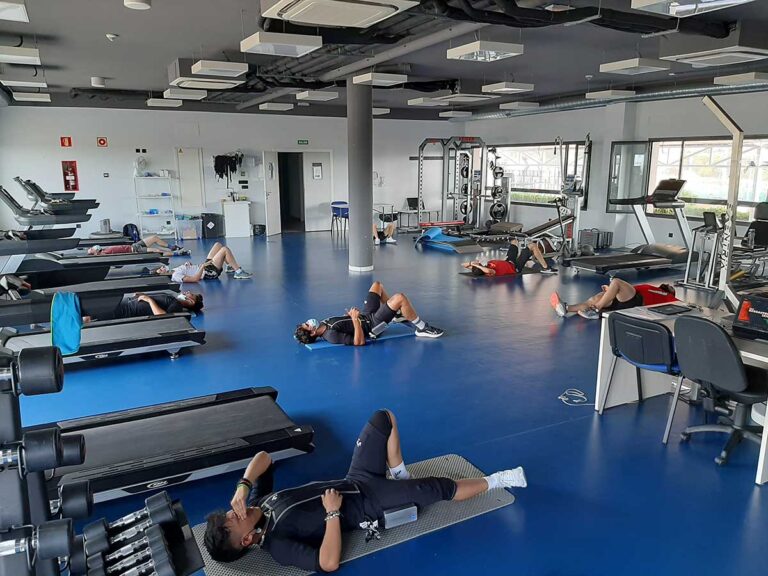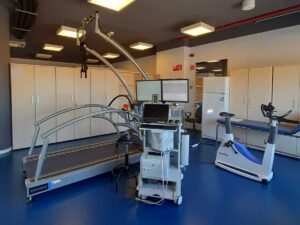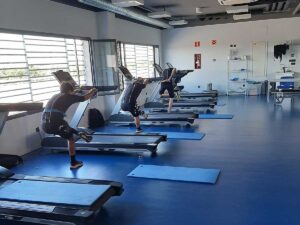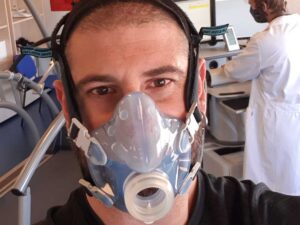In the previous study, we saw the drift that occurs in heart rate when we use whole-body global electrostimulation (WB-EMS) while performing a low-intensity aerobic elliptical exercise, and placing two different electrical frequencies (7 Hz and 21Hz).
On this occasion, and after seeing the results obtained in the derivation of the heart rate, we are going to focus on the results obtained through the Medical Graphics gas analyzer.
- Electrostimulation produces a greater energy expenditure:
First of all, the literature has shown that whole body electrostimulation or WB-EMS (Whole Body Electrostimulation) is an effective tool for increasing energy expenditure. For example, Boccia et al. compared the effect of electrostimulation on energy expenditure in middle-aged, moderately active, normal-weight men, and observed that electrostimulation training based on low-intensity resistance exercises for 15 minutes at 85 Hz, and with a 4-4 work cycle, it produced a higher energy expenditure (~7%) compared to training with similar characteristics without electrostimulation (1).
- Electrostimulation modifies energy expenditure:
On the other hand, the Profith research group has shown that training with electrostimulation can be effective in modifying energy expenditure (2).
These aforementioned studies carried out an intervention in which they measured resting energy expenditure before and after the intervention. However, other studies say they have not found changes in energy expenditure when electrostimulation is applied during exercise (3). As we can see, there is some controversy around the application of full body electrostimulation and its relationship with energy expenditure.
That is why from Wiems Lab we wanted to analyze what happens with energy expenditure when we apply these two intensities and for periods of 15 consecutive minutes.
Within the field of electrostimulation it is very important to emphasize that there are infinite ways of applying electric current. Thus, it may be that a certain application, for example 7 Hz, 200-400 pulse width, with a work rest time of 4-4 and an RPE intensity of 7, has no effect on energy expenditure, but the fact to modify the work-break time to 45-15, yes you have it. That is why we must be very exquisite when analyzing the literature and have the obligation to continue investigating the different forms of application of electrical intensity.
Initial study evaluation
As we have seen in previous posts, we carry out the evaluation of these two electrical frequencies and their repercussions on the body during low-intensity exercise, with aerobic exercise on an elliptical trainer and by putting on an electrostimulation suit of whole body.
For the analysis of energy expenditure it is necessary to carry out an evaluation of oxygen consumption and carbon dioxide production. To do this, we used a gas analyzer (Medical Graphics, Tewkesbury, England) that uses an “umbilical” as a link between the mask that is placed on the participant and the gas analyzer. In the following video we can see the test performed on one of our participants.
As can be seen in the image, the person was connected to a fixed gas analyzer at all times. Once the test was finished, the data was extracted and processed to obtain the energy expenditure in kcal per minute and every 5 minutes. Next, we present the result offered by the gas analyzer:
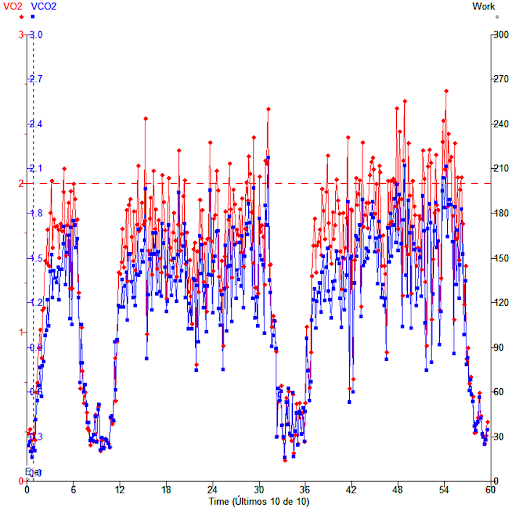
This image reflects the amount of oxygen consumed and the amount of carbon dioxide produced at each moment. On the X axis we can see the elapsed time of the test with a total of 60 minutes. It is clearly appreciated when the person begins to exercise since both values increase considerably. In this sense, we see that the person at all times has oxygen values higher than carbon dioxide, so we can confirm that the exercise was aerobic.
Study results
Next, we will present a summary table of the data processed from all the participants. Here we have the graphs of the volume of oxygen consumed (Vo2), carbon dioxide produced (Vco2, the relationship between both variables (RER) and the energy expenditure (EE) of all the participants in gray and the average in black.

These data help us to see that, during the second applied frequency, the values are generally lower. In fact, the clear example of this is seen in the production of carbon dioxide where we clearly see that it is lower in the second frequency. All the measured variables have this trend.
In order to compare both moments, we should carry out an analysis of the two moments, and see if there are statistically significant differences taking into account the moments in which it is 5/10, 7/10 and 8/10. This increase in intensity that we have commented on in previous posts is perfectly appreciated since each of the two moments has an upward trend. This slope shows that the intensity of the exercise has increased as a result of an increase in electrical intensity, since the exercise was stable at all times.
On the other hand, we have the raw values of each participant and their average. These data can guide us when calculating the number of kcal that we think can be “burned” in a given period of time, and at the intensity that we are discussing. Here we present the average kcal per 5 minutes of electrostimulation at 5/10, 7/10 and 8/10.
Kcal average
| P1 | P2 | P3 | P4 | P5 | P6 | P7 | P8 | Average | |
| Cardio | 6 | 8 | 9 | 7 | 6 | 7 | 6 | 6 | 7 |
| 5/10 1º FQ | 12 | 12 | 14 | 10 | 9 | 9 | 9 | 9 | 10 |
| 7/10 1º FQ | 14 | 14 | 15 | 10 | 9 | 9 | 11 | 11 | 12 |
| 8/10 1º FQ | 14 | 14 | 16 | 11 | 11 | 10 | 11 | 12 | 12 |
| 5/10 2º FQ | 12 | 11 | 14 | 10 | 7 | 9 | 7 | 8 | 10 |
| 7/10 2º FQ | 14 | 12 | 16 | 10 | 7 | 10 | 8 | 9 | 11 |
| 8/10 2º FQ | 13 | 12 | 18 | 11 | 8 | 11 | 9 | 11 | 12 |
We see that when electrostimulation is not applied, the person has an approximate energy expenditure of 7 kcal/min. However, when we apply the electro this energy expenditure increases to 10 and even 12 kcal/min with the 1 electrical frequency. As we can see, energy expenditure does not seem to depend on the electrical frequency used, since at both frequencies we are at 12 kcal/min when electrostimulation is applied at an RPE of 8/10.
On the other hand, we have the consumption of kcal that is done in those 5 minutes, comparing it with the period of cardio without electrostimulation. On this occasion we see that they go from “burning” 35 kcal in 5 minutes to burning:
- 52 kcal at 5/10.
- 58 kcal at 7/10.
- 62 kcal at 8/10 in the first frequency.
- 49 kcal at 5/10.
- 54 kcal at 7/10
- 58 kcal at 8/10.
Kcal average
| P1 | P2 | P3 | P4 | P5 | P6 | P7 | P8 | Average | |
| Cardio | 40 | 38 | 46 | 37 | 28 | 36 | 28 | 32 | 35 |
| 5/10 1º FQ | 60 | 62 | 68 | 49 | 43 | 46 | 43 | 44 | 52 |
| 7/10 1º FQ | 70 | 68 | 75 | 50 | 47 | 47 | 53 | 53 | 58 |
| 8/10 1º FQ | 72 | 70 | 78 | 56 | 53 | 50 | 55 | 62 | 62 |
| 5/10 2º FQ | 62 | 57 | 71 | 48 | 35 | 46 | 35 | 42 | 49 |
| 7/10 2º FQ | 70 | 59 | 81 | 50 | 35 | 50 | 38 | 47 | 54 |
| 8/10 2º FQ | 65 | 59 | 88 | 53 | 39 | 56 | 46 | 57 | 58 |
Finally, and by way of summary, we can say that the data shown in this study are summarized in that the kcal consumed increases by 40% when electrostimulation is applied at an RPE of 5/10, and 53% when an RPE of 7 is applied. /10 and 68% when applied to an RPE of 8/10.
| 1º FQ | 2º FQ | Average | |||
| 5/10 1º FQ | 45% | 5/10 2º FQ | 34% | 5/10 | 40% |
| 7/10 1º FQ | 61% | 7/10 2º FQ | 45% | 7/10 | 53% |
| 8/10 1º FQ | 74% | 8/10 2º FQ | 62% | 8/10 | 68% |
Conclusion
The data obtained in this intervention have been very useful to offer, once again, relevant information to the trainer and the professional of whole body electrostimulation or WB-EMS (Whole Body Electrostimulation). It is important to emphasize that these data are specific to the population we have used; however, we do not know if they can be extrapolated to other sections of society.
As a summary we can indicate that:
- The WB-EMS is an effective tool for increasing energy expenditure.
- There seems to be no CONCLUSIVE difference in the increase in energy expenditure between frequencies.
- The higher the RPE, the higher the energy expenditure.
Unai Adrian Perez de Arrilucea
Wiems Lab Team

